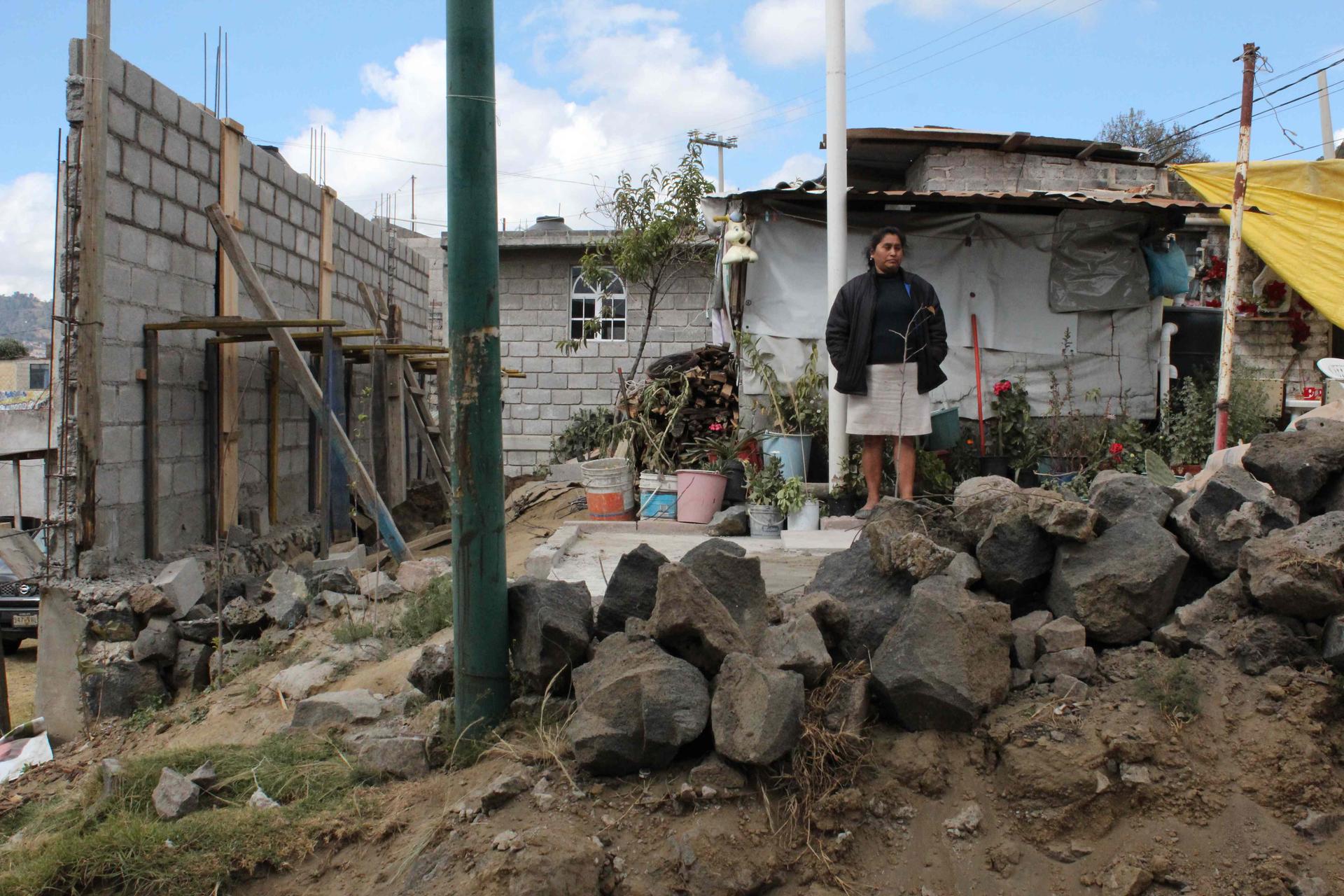In Mexico City, Harvesting Water from the Sky
Eusebia Santa Ana Gutierrez in her backyard on the outskirts of Mexico City. Her home receives only intermittent water from the city. (Photo: Ari Daniel Shapiro)
The Ajusco district at the southern edge of Mexico City is part of Mexico's surging capital, but you would never know it. It is almost rural. Aside from the occasional car or motorbike on a dirt road, the only sound is a radio playing somewhere in the neighborhood.
And there is another, less obvious sign of Ajusco's isolation from the rest of the metropolis. Most homes here have at best only intermittent access to the city water system.
Eusebia Santa Ana Gutierrez says in Spanish that for most of the time she has lived here, she has worried about water. Service has been erratic, she says, and she has never had enough. Sometimes it has gotten so bad, she has had to visit friends or family in the city center to wash her clothes or take a shower.
Gutierrez's situation is typical of tens of thousands of people here on the outskirts of Mexico City. But even in the more developed urban areas, roughly 30% of the city's residents have only sporadic access to water. That means millions of people.
The main problem is that as the city's population continues to surge — now beyond 21 million residents, the aquifer beneath the city is being depleted.
And that is where Enrique Lomnitz comes in.
Isla Urbana
Lomnitz is the director of Isla Urbana, a local environmental group that is pushing what it says is a simple solution to at least part of Mexico City's water crisis – rainwater harvesting. Lomnitz says, "As the water situation gets worse and worse, our proposal gets stronger and stronger."
He explains that rainwater harvesting is a natural fit in Mexico City, since over a million homes already have tanks, or cisterns, for storing water from either the intermittent city water system or delivery trucks.
He says, "So you put a rainwater harvesting system into [a] house. You don't have to buy a cistern because these things are already part of the house's infrastructure. And it's not a novel concept for a family to have a whole bunch of water come into their cistern at once, and then use that water so that it lasts as long as possible. This is something that people are very used to doing."
Lomnitz says water from the rainy season in the summer and fall can supply a household for up to six months. And with tanks already in place, he says Isla Urbana's system is quick and easy to install. All that is required are some new gutters to channel the rainwater, new plumbing to draw off the first flush of water in a rainstorm, which is often contaminated with air pollutants, and a couple of special filters. The total cost is no more than six hundred bucks per household.
He and his team have already installed close to a thousand systems in Mexico City, split between the rural outskirts and the urban center.
Rainwater Skeptics
Not everyone is convinced of the benefits, however.
Victor Carrillo lights a blowtorch in his workshop to weld two copper pipes together. He used to be a bus driver, but now he works for Isla Urbana, training plumbers to install rainwater systems. He says it can be a tough sell.
Carrillo says in Spanish that plumbers sometimes make fun of the program. They do not understand the culture of rainwater harvesting.
But after the training, he explains that most of the plumbers eventually come around, and they see the benefits.
That is not the case, however, for city officials.
"It is not a solution," says Ramón Aguirre Díaz in Spanish, the Director General of Mexico City's Water System. "It sounds intelligent and ecological. But that is it — it just sounds good."
Aguirre Díaz says the cost and the extra technology put rainwater harvesting out of reach of the vast majority of Mexico City's homes.
And he says the problem this giant city has with its water cannot be fixed with a single approach. They need to rely on many ideas, like reducing demand and increasing water reuse, fixing leaky water mains, and bringing more water in from outside the city.
Enrique Lomnitz and his colleagues at Isla Urbana agree that rainwater harvesting is not going to fix Mexico City's water problems entirely, but he believes it has much greater potential than the city gives it credit for. And he says their approach is already making a big difference for people who have installed their systems.
Water from the Sky
Eusebia Santa Ana Gutierrez (on the outskirts of the city) is one of these people. Isla Urbana helped install a rainwater harvesting system in her home last year. Fifteen of her neighbors have done the same.
Gutierrez casts a bucket down into her water tank, still half-filled, even though it has been two months since the last rain. She can see her reflection in the water below.
She shows off the water she uses to wash her clothes and her dishes. She even drinks it, though Isla Urbana does not advise it. She says, "It is crystal clear, this water that came from the sky."
Gutierrez is relieved that she has not had to worry about her water for the past few months. She also says she is saving enough money from not having to buy water to build a little extension onto her home. Once it is complete, she plans to collect even more rainwater from her expanded roof.
She is proud of her setup, here on this dirt road at the edge of Mexico City. And the name of that road is Tlaloc — the Aztec god of rain.
